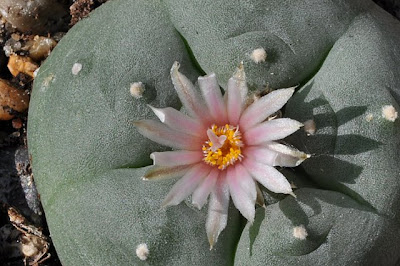All of the photos in this post were taken at the beginning of April to illustrate some of the spring activity in my coldhouse. The plants have been kept dormant all through winter and received their first drink of water only a few days before these pictures were shot.
Flowering Lophophora williamsii (El Huizache, San Luis Potosí)
The first plant I want to show off is a flowering Lophophora williamsii grown from seed originating from the El Huizache, San Luis Potosí, Mexico population (the population Anderson assigned as the neotype for the species). These plants are from a more southerly location than the ones I'm usually growing and I'm happy to see they are coping so well with the cold conditions during winter. I was getting used to thinking of all L. williamsii varieties as self-fertile but according to the Cactus Conservation Institute, greenhouse breeding experiments by Bohata and colleagues in the Czech Republic and by Köhres in Germany have shown that plants from the El Huizache population are self-sterile and therefore obligate outcrossers (leading one to suspect a great deal of genetic diversity within plants from this population – in contrast to the self-fertile populations that have little to no genetic diversity among individuals as they outcross very little). 
Lophophora williamsii (El Huizache) flower with long style
The flowers of the El Huizache plants also seem to have a very long style that raises the stigma well above the stamens, making it hard, if not impossible, for the plants to reproduce without the help of a pollinator.
Bumble bee having fun with a Lophophora williamsii flower
Speaking of pollinators a bumble bee visited while I took these pictures – unfortunately only this one Lophophora flowered at the time making it impossible for the bee to fertilize the plant. The bumble bees that are active in early spring are huge; I don't know much about bees but am told that these large slow individuals are queen bees looking for nectar and pollen to feed their newly hatched brood.
Lophophora williamsii (SB 854; Starr Co, Texas) with fresh fruit
One of the Lophophora williamsii (SB 854; Starr Co, Texas) plants that I recently repotted has spawned a fruit. This variety of Lophophora williamsii is self-fertile to an extent where it happily sets seed if you just shake the flower a bit.
Flowering Acharagma roseana (LX 578; Ramon Arizpe, Coahuila)
My Acharagma roseana plants (LX 578; Ramon Arizpe, Coahuila - “Ramon” should probably read “Ramos” but I'll stick to the information from the vendors seed list) are coming of age. The plants were started from seed 4 years ago and are all ready to flower, displaying a wealth of flower buds. Only one, shown in the picture above, flowered when I took the pictures. Unfortunately it will be a while before I can visit my summerhouse (and coldhouse) again – I hope at least a few of the flowers will be saved for then. My Echinocereus reichenbachii plants are also growing a multitude of buds, getting ready for a flower fest I would hate to miss.
Frost damaged Matucana madisoniorum
Until now I have focused entirely on the success stories but a few of my plants didn't like being without heat during winter. My Matucana madisoniorum definitely didn't like the cold conditions (even being wrapped in multiple layers of horticultural fleece). The plant is heavily marked by the experience but survives.
I also lost a few plants: a couple of Carnegia gigantea (saguaro cactus), a Cylindropuntia bigelovii (teddy-bear cholla), and a Cylindropuntia tunicata (thistle cholla); I managed to save cuttings of the chollas though. These plants were kept out on the terrace all summer and I probably left them out for too long, exposing them to the autumn storms so the plants were not able to dry out completely before winter. I'm especially sad about the Carnegia gigantea plants as they were great specimens and are now completely reduced to mush.
Malpighia 1927 v.30 (added: 11/24/2025)
-
*By:*
Borzi, Antonino,1852-1921.
Penzig, O.1856-1929.
Pirotta, Romualdo,1853-1936.
*Publication Info:*
Messina : g. Capra & co., 1887-89 ; Genova : Tip. di A...
5 weeks ago



















Nice to see the bees visiting your lophophora! Just one worry though - if you're using Imidacloprid to control RSM, there is a risk that the bee may take the pesticide back to the hive. Bees are particularly vulnerable to Imidacloprid.
ReplyDeleteIt is said that Acharagma is closely related to Lophophora and that it may be possible for them to interbreed and create hybrid offspring!
ReplyDeleteHave you ever tried making a hybrid between Lophophora and anything else?
My Acharagma roseana flowered for the first time this spring (and my A. aguirreana are still small seedlings) so I haven't made any controlled experiments yet. I'm planning to, though - the results of Butterworth et al. indicate a close relationship between Acharagma, Lophophora and Obregonia so chances are they will crossbreed, as you say. I haven't made any other hybridization attempts either.
ReplyDeleteI have been pondering what constitutes a "safe protocol", i.e. how to minimize the possibility for selfing. I'm imagining protecting the stigma from the stamens with e.g. a plastic straw and then carefully remove the stamens, but suggestions are welcome.
A friend and I pollenated a lophophora williamsii which is self-sterile with an obregonia... About a month later a seedpod popped out containing only 2 seeds, but seeds none the less. Am waiting to see if they germinate at the moment.
ReplyDeletePlease keep me updated on how this develops! Your method is as beautifully simple as it is effective, and I plan on shamelessly copying it ;-) (even though I've read somewhere that foreign pollen can induce self-fertility; I haven't been able to find any conclusive information on this, though)
ReplyDelete